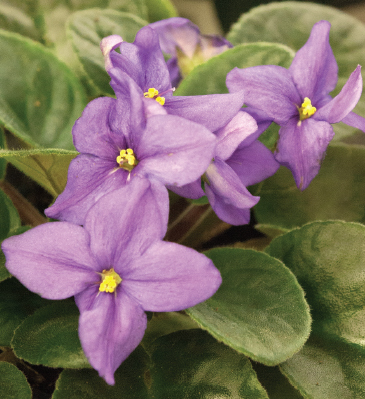African violets are just the right perky plants to help avid gardeners shed the dead-of-winter blues. While these potted beauties are dependable performers, they can still have problems, but many are fairly easy to spot, diagnose and treat. Here are some of the more common African violet ailments and what to do about them:
Lopsided plant. This odd look is simply the result of having one side toward the primary light source too long. Rotating the plant a quarter turn once every week will take care of this out-of-kilter condition.
Spotted leaves. Either cold water or chlorine is the probable cause. Apply water directly to the soil, not the leaves, and let it warm up to room temperature before using. Having water sit out overnight allows any chlorine — common in city water — to dissipate, but using room-temperature rain water will also solve the problem.
Curled leaves. This is usually the result of fertilizer salts building up on the rim of the pot, burning leaves that come into contact with the residue and creating the curled condition. To curb the curl, don’t over-fertilize the plants, and occasionally wipe the rim and sides of the pot clean.
Few or no blooms. In addition to proper fertilization (which, by the way, should be held back during the winter months), appropriate sunlight, warmth and humidity are the keys to bountiful bloom displays. Sunlight should always be indirect. African violets will do fine in a bright room exposed to weak winter sun. The summer sun will be too harsh, of course, but translucent shades will help take some of the bite out of the stronger rays. As far as a proper location for warmth, set them in a spot away from drafts with temperatures between 65 and 75 degrees.
Humidity requirements indoors can be generally met by placing the pots in a shallow tray of pebbles almost filled with water; the tops of the rocks should be dry.
Scraggly growth. S-t-r-e-t-c-h-e-d out leaves mean not enough light. Shoot the shine to ’em. But don’t get too carried away because this could lead to…
Yellow leaves. Way too much light, and the source is usually direct sunlight in the summer.
Blooms fade or change color. All African violet flowers will do this when they get old, but if it happens prematurely, the probable cause is plants being subjected to sharp changes in temperature. Maintaining steady temperatures is the key to constant color from African violet blossoms.
Root rot. The result of watering too frequently, or the plant roots being constantly submerged in water. Only water when the top of the soil feels dry and don’t set the pots in saucers that can trap water. Also, be sure the plants are potted in loose, well-draining soil.
L.A. Jackson is the former editor of Carolina Gardener Magazine. Want to ask L.A. a question about your garden? Contact him by email at: lajackson1@gmail.com.
To Do in the Garden – January
- know about your garden’s ground now, the better you will be able to tend to your plants’ needs during the growing seasons.
- Autumn is but a memory now, but still be vigilant about keeping fallen tree leaves off the lawn to prevent them from becoming matted down and suffocating new or established grass.
- If you need to use wire to keep a new tree planting straight, slip a piece of old hose onto the line and place it where it comes into contact with the tree. This prevents the wire from cutting into the bark.
- Notice how ornamental grasses add vertical, flowing structure and interest to the garden now and plan to plant more in future winter gardens.
- It is certainly not too early to begin buying seeds from garden catalogs and online sites in order to have young sprouts ready for the spring growing season!
- When picking out vegetable and ornamental plants for this year’s garden, consider not only disease- and insect-resistant varieties but also drought-tolerant selections.
- Yes, there can be a drought during the winter. That is why it is a good idea to maintain mulches through the cold months and water newly established plants regularly if the rains don’t come. Also, evergreens will lose less water if an anti-transpirant spray such as Wilt-Pruf is applied during extended cold, dry times.
- Winter-flowering camellias (Camellia japonica) should begin to bloom in a big way this month, but after the show, there is a job to do. Be sure to rake up and dispose of any spent flowers that have fallen underneath the bush to help discourage camellia petal blight, a disease that can give your pristine blossoms a serious case of the uglies.







